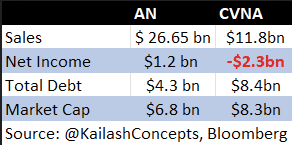Carvana Co (NYSE:CVNA) reported its Q2 numbers on Wednesday (July 19th) along with announcing a debt restructuring and sale of equity to raise up to $1.3 billion. I’ll briefly review the financials. Net sales of $2.9 billion (retail, wholesale, other) were down 23.7% YoY and up slightly from Q1 2023.
The Company managed to slash costs enough to generate a small operating profit in Q2, though after interest costs net income before taxes was negative $105 million. A big improvement over the 2022 Q2 NIBT of -$438 million. However, I suspect particularly with used car prices heading south quickly that Q3 for CVNA will show lower revenues and a much wider operating/NIBT loss.
The nuts and bolts behind the revenue numbers are ugly. Retail units sold dropped 35% YoY. The wholesale operations acquired in the ADESA transaction are small compared to retail so I’ll leave that out. The operations generated $509mm in cash but that’s because CVNA continues to sell more vehicles than it replaces. Inventory has declined from $1.87 billion at year-end 2022 to $1.3 billion at the end of Q2. This is not a sustainable business model. CVNA slashed operating costs substantially but cut headcount by more than 4,000 and slashing its marketing expenditures.
Fundamentally CVNA’s business is shrinking. This will get worse in Q3 as both the Company and Autonation (see below) warned that used car prices will fall further in Q3. In all likelihood, the average cost per vehicle in CVNA’s inventory is not much lower that the price it can realize in the market now.
CVNA also announced a debt restructuring that will involve exchanging $5.6 billion in debt that matures between October 2025 and May 2030 for $4.3 billion of new notes that mature in December 2028 through June 2031. The new notes have a PIK feature for up to two years (pay-in-kind, meaning the Company can pay the interest expense for up to two years in more bonds rather than cash). However, the PIK feature comes at a steep cost. The existing debt carries an average coupon roughly of 8.9%. One tranche of the new notes has a PIK coupon rate of 12% and 9% cash thereafter while a second note tranche carries a PIK coupon of 13% and 11% cash thereafter and the third new tranche has a 14% PIK and 9% cash thereafter.
The weighted average cost of the PIK debt payments is roughly 13.1%. If CVNA chooses to PIK the notes for the first two years, after two years there will be roughly $5.6 billion in notes outstanding ($4.3 billion compounded 13.18% over two years). Not really a debt restructuring, is it? In conjunction with the debt restructuring CVNA will try to sell up to $1 billion in new shares via a series of ATM transactions (at-the-market in which the brokerages representing CVNA will intermittently dump new shares on the open market).
The mainstream media stated that the debt deal will save CVNA $430 million in interest expense over the next two years. But per the math I showed above, CVNA’s total cost of interest rises. To be sure, the deal will save CVNA from making cash coupon payments on the debt for two years. But from an accounting standpoint, it will still have to recognize the PIK payments as a GAAP interest expense.
This deal doesn’t help CVNA financially at all except short term from a liquidity standpoint. In fact, S&P said it views the restructuring as “distressed and tantamount to default.” The debt ratings were put on negative watch. The next downgrade would assign a “D” for “default” rating. Given that new notes will be secured by a 1st priority lien on all of the assets that are not used to secure the Ally Financial (NYSE:ALLY) inventory financing facility. The notes will have a 2nd lien on those assets (used cars).
CVNA’s balance sheet is thus still a mess, with what ultimately will be $5.6 billion in debt outstanding on a company that continues to generate operating losses and whose business is shrinking. Website visits are down nearly 40% YoY and the number of vehicles listed online is down almost 50%. In the context of the debt “restructuring” and the need to raise a lot more cash, CVNA is on life support. This Company in my view will hit bankruptcy sometime in the next 12-18 months.
The stock is another matter. The stock price has shot up from under $4 at the end of 2022 to as high as the $55 close on Wednesday. Make no mistake, this was 100% the product of a short-squeeze and a call option gamma squeeze. The short interest at the end of June was over 50% of the float. It was 43% of the float on June 15th. This stock is such an obvious short that any entity that can secure a borrow and finance it is short the stock. On Thursday the stock dropped 16.2% and another 2.4% on Friday.
Carvana’s market cap is absurdly disconnected from reality, notwithstanding the fact that the stock is intrinsically worthless, it does not even have “optionality” value. Autonation (reviewed below) is still extremely overvalued even after Friday’s cliff dive. But here’s a comparison of the two companies:

Carvana is probably one of the most obvious shorts on the NYSE, which is why the short interest at times exceeds 50% of the float. The put options have a high amount of implied volatility but if you go out far enough and play OTM puts, it will pay off eventually. Short calls to take advantage of the high option premium is probably the best way to express a short view on CVNA. If you can obtain, finance and hold onto borrowed shares, you will never have to cover because ultimately the shares will be canceled in a bankruptcy restructuring or liquidation scenario.
